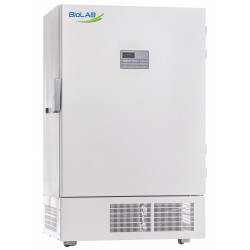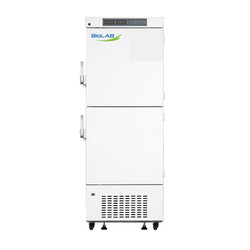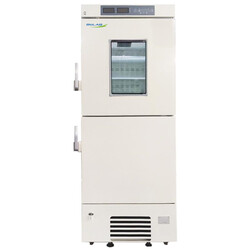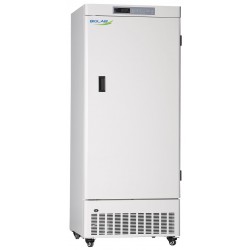The Overview of Ultra Low Temperature Freezer
The Overview of Ultra Low Temperature FreezerOften an Ultra-Low Temperature (ULT) freezer is an absolute necessity when you have valuable samples to protect. Covid-19 vaccines are just one of the many uses for ultra-low freezers. There are a number of crucial variables to take into account whether you're purchasing a device for the first time or need to replace an outdated device. Since these machines are obviously much more expensive than standard freezers, you need to be certain that you're getting the greatest freezer possible for your requirements.
You may find information on when and how to specify one of these units in this post.
What are Ultra-Low Freezers ?
A refrigerator that stores products at an Ultra-Low Temperature (ULT) range in temperature from 40 to 86 °C (40 to 123 °F).In reference to the most widely used temperature standard, an ULT freezer is frequently referred to as a "minus 80 freezer" or a "negative 80 freezer."
How do freezers with ultra-low temperatures function?
A single vacuum - sealed high-power compressor or two cascade compressors can function as an ultra-low temperature freezer. The two-circuit cascade solution involves connecting two refrigeration circuits so that the evaporator from one cools the condenser from the other, allowing the compressed gas in the first circuit to condense more easily.Laboratory ULT freezer systems often use air-cooled condensers. They are made up of copper or copper-aluminum tubular batteries that are designed to maximise surface heat transfer. An engine-driven fan forces the cooled air to circulate, and capillary tubes provide the refrigerant fluids' expansion.
Evaporation occurs either via coils or steel plate heat exchangers that are located inside the chamber. The efficiency issue in the heat exchange of freezers with coils in the insulating cavity is remedied by the cabinet coil.
Finding a Suitable ULT Freezer
Here, we'll take a comprehensive look at the features you should take into account when purchasing a ULT freezer.1. Capacity -
Without uncertainty, a freezer's capacity is one of its key characteristics. We therefore provide wide range of sizes across all of our ULT freezers.
Additionally, you must select between an upright freezer or a chest freezer. If you regularly need to obtain samples, an upright freezer might be chosen because it is easier to access. However, due to the tendency of colder air to travel downwards, vertical freezers are slightly less efficient as the cold air is more prone to escape during door openings.
2. Temperature -
Temperature is indeed a crucial factor to consider based on the type of material you want to preserve.
We offer ULT Freezer’s in variety of ranges such as -
Laboratory ULT freezer of ranges -25 °C , -40 °C and -60 °C

Ultra-Low Temperature Freezer -25 °C (Upright Freezer)

Ultra-Low Temperature Freezer -40 °C (Upright Freezer)
Ultra-low freezers of ranges -86 °C and -150 °CCombined Refrigerator and Freezer with Refrigerator of range Ultra-low freezers of ranges +2°C to +8°C and Freezer range of 10°C ~ -25°C or 10°C ~ -40°C

Ultra-Low Temperature Freezer -86 °C (Chest Freezer)

Ultra-Low Temperature Freezer Double Door Freezer
3. Energy Efficiency -
Modern ULT freezers help reduce energy expenses and the carbon footprint of the laboratory. For a better return on investment, hydrocarbon refrigerants (HFCs) are frequently used in ULT freezers.

Ultra-Low Temperature Freezer
4. Alarm System -
You ought to seek whether anything has gone awry since temperature fluctuations might be devastating for your samples. If you have appropriate warning systems in place, you may have time to take action before it's too late.
Some devices have alerts that are both loud and visible, indicating factors like temperature changes malfunction, power outages or sensor malfunction. If there is an electrical or mechanical problem, certain ULT freezers include auditory and visual alarms that indicate it.
Conventional Applications of Ultra-Low Freezers
Developments concerning biological and biotechnological preservation employ ultra-low freezers extensively. To list a few diverse application of it -• Most notably - storage of the covid-19 vaccines
• Hospitals and healthcare centers - Organ transplants
• Research universities - to store biological samples such as dna/rna, plant samples and insect artifacts.
• Forensic laboratories for long-term preservation of evidence – to preserve autopsy materials, blood, plasma and tissues.
• Chemical R&D Labs - Storage of chemicals, drugs and antibiotics. These cabinets are increasingly being acquired for sample and chemical preservation in chemical laboratory in schools.
• Blood Banks and Plasma Storage Banks
All such varied applications suggest that various experiments may be performed in ultra-low freezers, some of which might need to be monitored frequently while others can go uninspected for prolonged periods.
Ways to extend life of your ULT Freezer
Ultra Low-temperature (ULT) freezers are an essential standard component in laboratories all over the world, If used and maintained properly, these specialised units can provide 10-12 years of dependable service, but to get the most out of them. It thus includes locating them wisely, ensuring they have the correct voltage power supply, and performing essential preventive maintenance functions to ensure that they operate optimally.To name a few examples -
• Decrease the accumulation of frost or ice.
• Thaw the chamber on a constant schedule.
• Maintain the condenser's hygienic conditions.
• Sanitize the door gaskets.
• Recognize freezer alarms.
Do you require a ULT Freezer?
We provide a diverse range of Ultra Low Temperature freezers to fulfill a diversity of requirements. Browse our -150°C Cryogenic Freezer, with ranges of -25 °C Freezer, -40°C Freezer , or -86°C ULT Freezer and additionally our Double Door Freezer.You May Also Like














